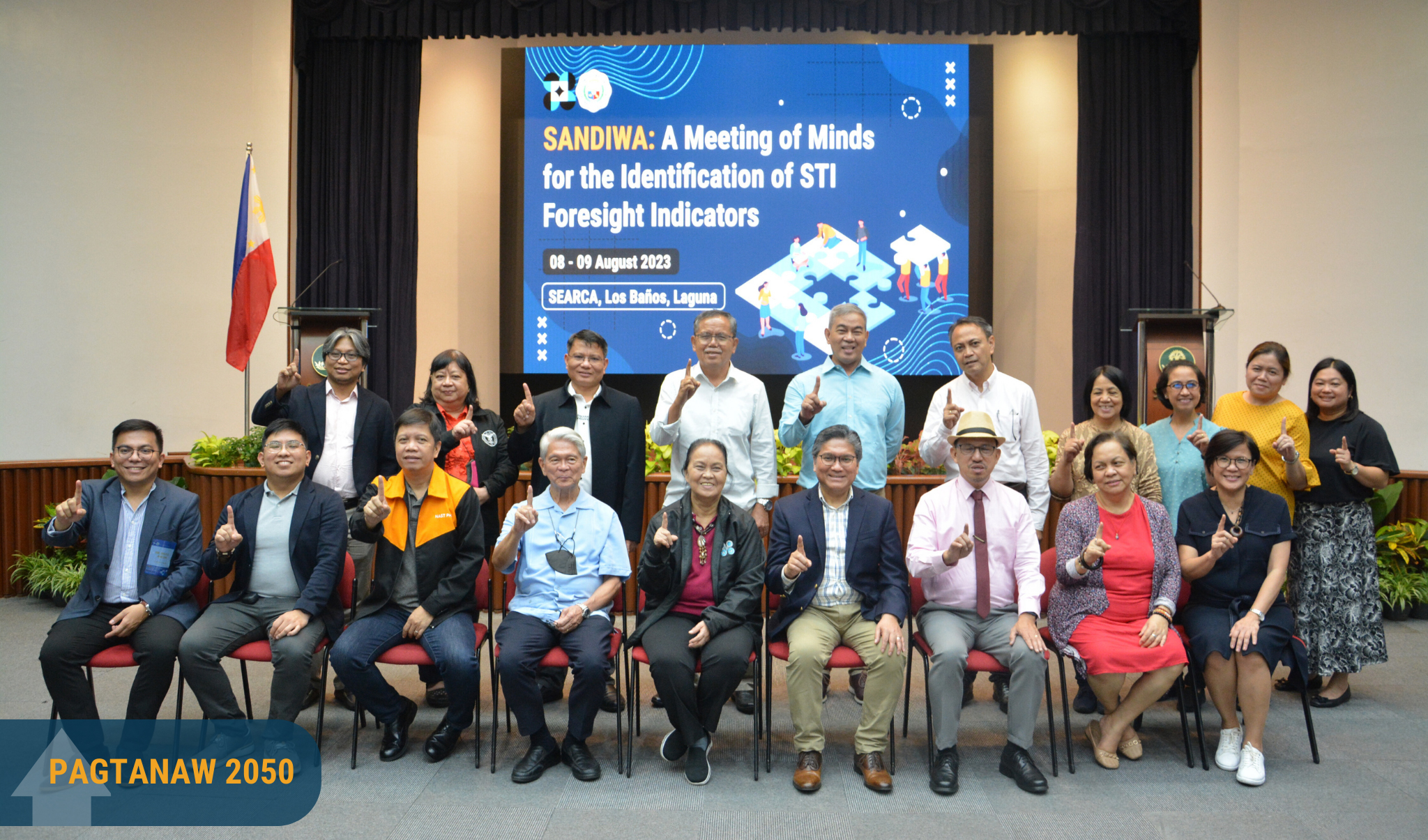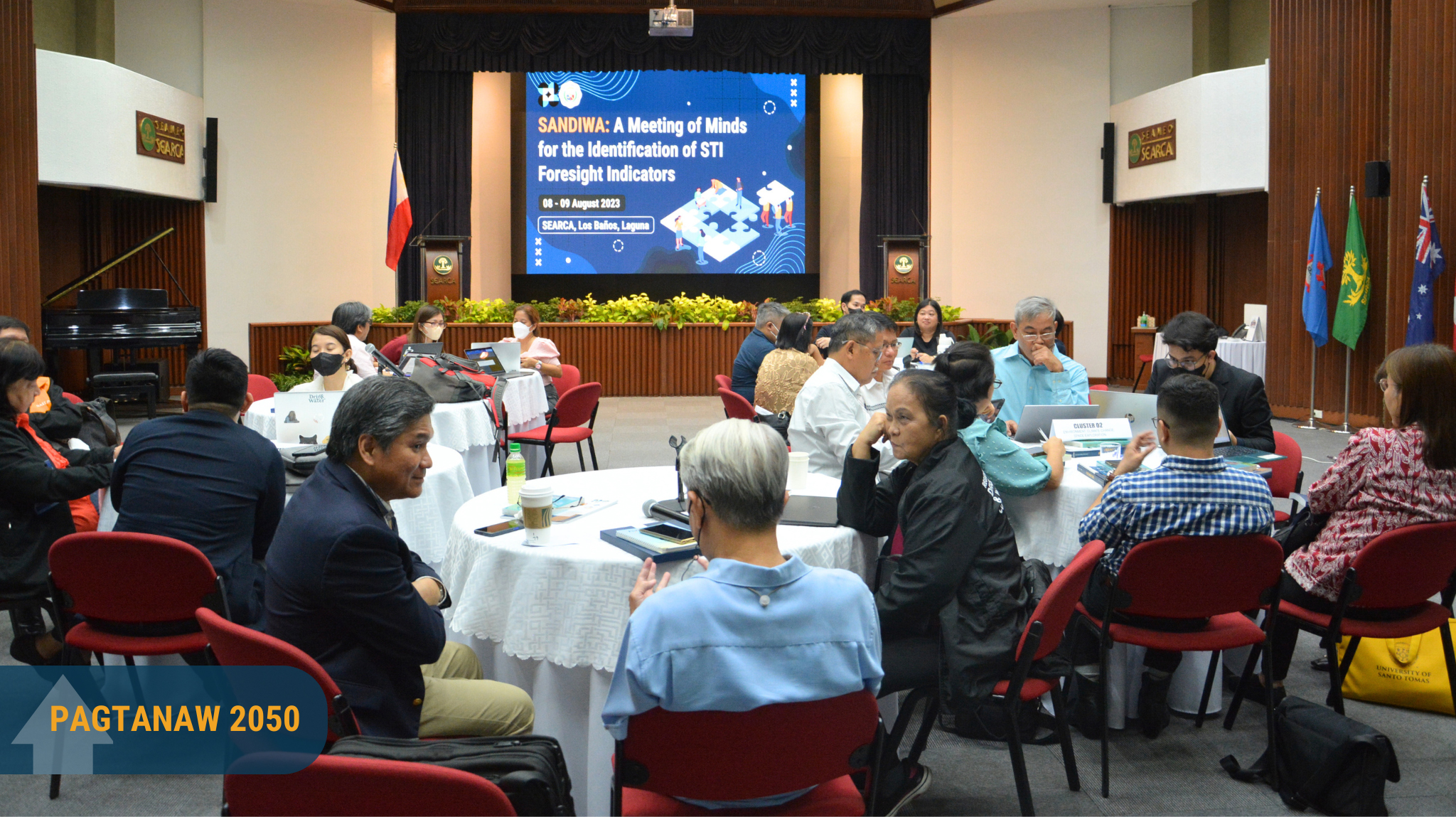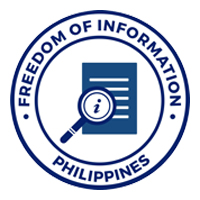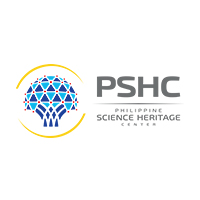The National Academy of Science and Technology, Philippines (NAST PHL) conducted a 2-day workshop titled “SANDIWA: A Meeting of Minds for the Identification of STI Foresight Indicators” on August 8-9, 2023, at the Southeast Asian Regional Center for Graduate Study and Research in Agriculture (SEARCA), Los Baños, Laguna.
The workshop was attended by the Department of Science and Technology (DOST) Assistant Secretary, Dr. Napoleon K. Juanillo Jr., the PAGTANAW 2050 Project leader, Academician Rhodora V. Azanza, STI Foresight Steering Committee chaired by Academician William G. Padolina, and STI Foresight Think Tank co-chaired by Academician Glenn B. Gregorio and Academician Mudjekeewis D. Santos.

Representatives from different State Universities and Colleges (SUCs), Private Higher Education Institutions (PHEIs), Local Universities and Colleges (LUCs), government agencies, and non-government organizations were also able to attend the workshop. The list of representatives is as follows:
Onsite attendees:
-
Mr. Bryan James E. Erfe
Business Development Officer, Ateneo De Manila University -
Dr. Magdaleno R. Vasquez Jr.
Director, Technology Transfer and Business Development Office, University of the Philippines Diliman -
Dr. Cecilia B. Moran
Executive Assistant for Research Operations and Management, University of Santo Tomas -
Dr. Nathaniel C. Bantayan
Vice Chancellor for Research and Extension, University of the Philippines Los Baños -
Dr. Mona Lisa B. Lacson
Director, Center for Advanced Research and Innovation, Angeles University Foundation -
Dr. Nathaniel R. Alibuyog
Vice President for Research and Extension, Mariano Marcos State University -
Dr. Allen A. Espinosa
Director, Educational Policy Research and Development Center, Philippine Normal University -
Dr. Wilma S. Reyes
Faculty, Philippine Normal University Graduate School -
Dr. Dante M. Aquino
Director, Higher Education Regional Research Center (HERRC), Isabela State University -
Dr. Janet Lynn M. Balagtey
Director, Higher Education Regional Research Center (HERRC), Benguet State University -
Dr. Cynthia G. Kiswa
Director, Northern Philippine Root Crops Research & Training Center (NPRCRTC), Benguet State University
Online attendees:
-
Dr. Lourdes M. Portus
Executive Director, Philippine Social Science Council -
Dr. Jose R. Lacson Jr.
Consultant, Philippine Social Science Council -
Mr. Wilson C. Villones
Head, Program Development and Management Section, Philippine Social Science Council -
Mr. Miguel Alvaro L. Karaan
Training Officer, Philippine Social Science Council -
Ms. Pathricia Ann V. Roxas
Research Ethics Officer, Philippine Social Science Council -
Mr. Klint Ian V. Austero
Knowledge and Technology Transfer Office Manager, Siliman University -
Mr. Neil A. Malijan
Technology Business Incubator (TBI) representative, Siliman University -
Ms. Janice Antoniette V. Forster
Technology Business Incubator (TBI) Manager, Siliman University -
Mr. Vincent C. Barcelona
Administrative Officer IV, University of Makati -
Mr. Ricardo P. Babaran
Former Chancellor, University of the Philippines Visayas
The workshop was part of the initiatives of NAST PHL with support from DOST to increase the visibility of PAGTANAW 2050: The Philippine Foresight on Science, Technology, and Innovation. Participants were gathered to cultivate collaboration, exchange profound insights, and lay the groundwork for the operationalization and institutionalization of STI Foresight.
During the workshop, possible STI Foresight Indicators were identified and grouped into four clusters that underscore the interrelatedness and interconnectivity of the twelve (12) key operational areas: Food, Nutrition, and Health; Water and Energy; Environment and Space Exploration; and Built Environments. These indicators will have to be further refined through wider consultations among stakeholders.
For the food, nutrition, and health cluster, these initial indicators were identified: affordability, availability, quality and safety, health service delivery, health workforce, health information, essential medicines, and health financing. For the water and energy cluster, power supply, gas emission, water recycling, and seawater desalination were among the many general indicators that were listed down.
Furthermore, for the environment and space exploration cluster, participants were able to identify the number of evacuation centers, the presence of a localized curriculum/ material for education, the amount spent in geomatics/ geospatial research in SUCs, weather information usage, etc.
Lastly, for the built environments cluster, among the many indicators identified were the number of patent grants and PCT (Patent Cooperation Treaty) applications, technologies available, and maps/data sets for urban development.

Academician Padolina emphasized that the current developments in science and technology have allowed us to see more, sense more, and detect more, and to use these tools to facilitate innovation.
He stressed that aside from Digital Transformation, the exciting discoveries in genomics, new materials, and rapid, high-throughput chemometric methods should be harnessed for innovations in our national development agenda.
Meanwhile, DOST Assistant Secretary Juanillo Jr. expressed his desire to look for a specific and concrete vehicle through which he could use the workshop's output. He also emphasized the importance of the presence of representatives from various SUCs, PHEIs, and LUCs since this will help them in recrafting their research and extension agenda.
“The DOST has three hundred twenty (320) approved plantilla positions for provincial S&T officers. Therefore, there will be reorienting, retraining, and socializing the concept of foresight thinking with them,” he said.
Academician Azanza added that STI Foresight was conceptualized to scan the horizon, set the preferred future, and strategize, highlighting emerging opportunities and threats. She encouraged the participants to give more weight to the pull of the future and the push of the present in strategizing and monitoring. The weight of the past should not be pulling efforts down but considered as lessons learned.
On the other hand, Dr. Rico C. Ancog, STI Foresight Think Tank Member, emphasized the need for a strategic operationalization framework and performance indicators to establish an iMEAL system (Monitoring, Evaluation, Accountability, and Learning) that pertains to all the indicators, tools, and processes for the assessment and monitoring of PAGTANAW 2050 plan toward a desirable evaluation. He stressed that this can help inform decisions, promote accountability, ensure desired impact, and also identify corrections and lessons learned along the way.
Moreover, Dr. Nathaniel C. Bantayan, Vice Chancellor for Research and Extension at the University of the Philippines Los Baños, shared the basis of their discussion for the Environment and Space Exploration cluster and stressed the idea of the environment being the concern and science exploration as the tool. He further opined that the role of the local government is overwhelmingly important, and the battleground is located at the barangay level. He said that we need to capacitate, emancipate, facilitate, and give all the support because that is where all the issues are happening and that is where we can have success.
Dr. Ancog concluded the workshop by emphasizing that this is only the beginning of a series of workshops and meetings for the identification of STI Foresight indicators. After this, there will be a finalization of sub-group STI indicators, a meeting of the Steering Committee/ Technical Working Group and DOST Councils including the Undersecretaries and Assistant Secretaries and PH University Network, and integration of all STI indicators output.
PAGTANAW 2050 is the first DOST-funded inter-disciplinal and trans-disciplinal project on Philippine-focused STI Foresight and Strategic Plan that would impact the aspirations of the Filipino people on or before 2050: A Prosperous, Archipelagic, and Maritime Nation.
For more information about PAGTANAW 2050, you may visit the NAST PHL website at https://nast.dost.gov.ph/index.php/pagtanaw-2050 and social media accounts through Facebook, Instagram, Twitter, and LinkedIn: @pagtanaw2050










